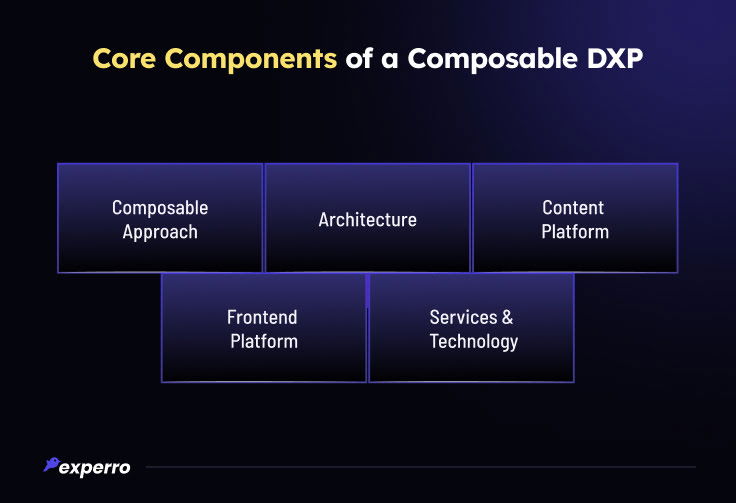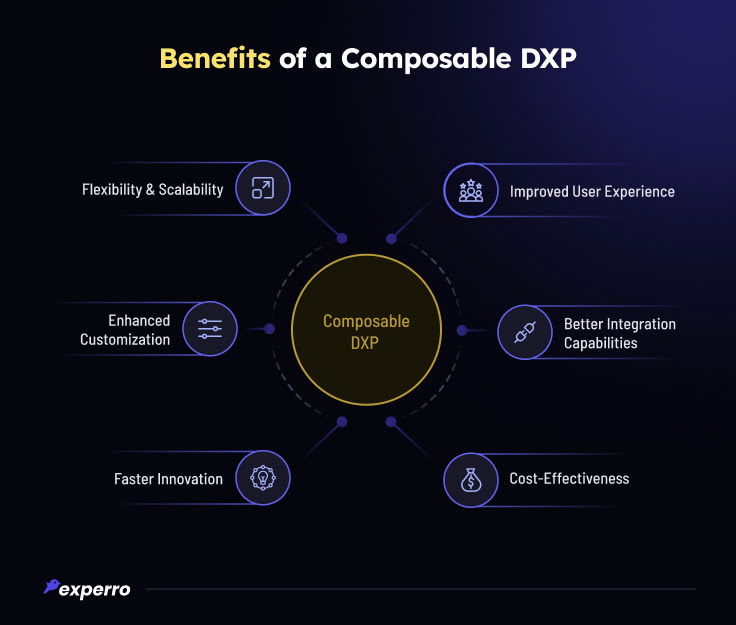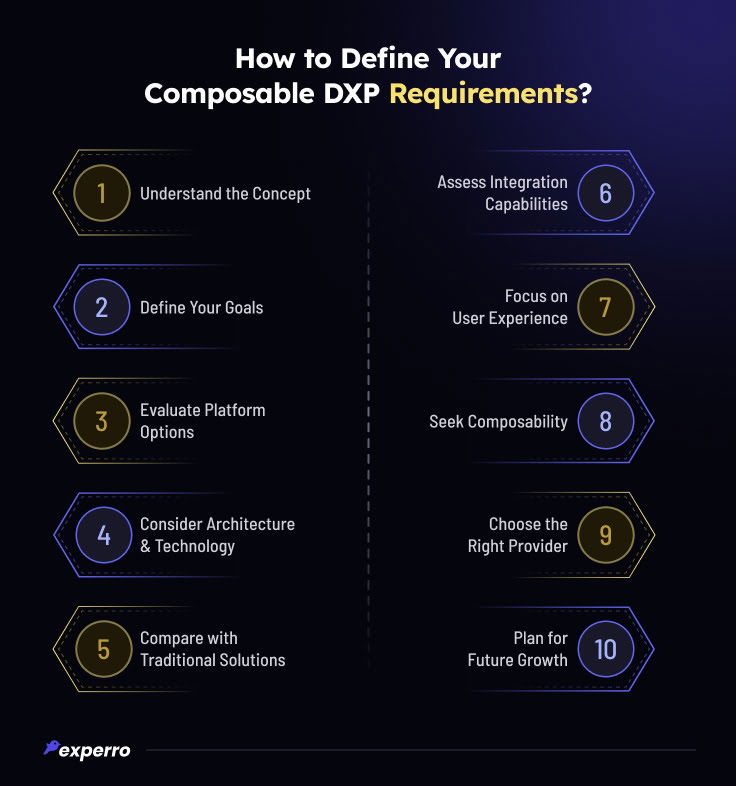Composable DXP: Exploring Benefits and Strategies

What’s Inside
- What Is a Composable DXP?
- What Does a Composable DXP Look Like?
- What Are the Core Components of a Composable DXP?
- How Does a Composable DXP Work?
- What Are the Benefits of a Composable DXP?
- How to Define Composable DXP Requirements?
- What Are the Considerations for Implementing Composable DXP?
- Composable DXP vs. Monolithic DXP
- Composable DXP vs Traditional DXP
- Why Is the Future of Businesses Composable?
- Why Is Experro the Best Composable DXP?
- Conclusion
- A composable DXP is a flexible platform that allows businesses to customize their digital experiences with interchangeable parts.
- There are three types of digital experience platforms; CMS DXPs, Headless DXPs & Portal DXPs.
- A composable digital experience platform offers adaptable frameworks for agile innovation, outpacing traditional monolithic systems.
- Adopting a composable DXP approach can lead to cost savings by allowing businesses to invest only in features that meet their specific needs, eliminating unnecessary expenses.
- Experro as a complete DXP provides unmatched flexibility and seamless integration by providing headless solutions.
Are you ready to revolutionize your digital strategy with a composable DXP?
Unlike traditional monolithic CMS systems, a composable DXP offers a flexible architecture that allows businesses to select and integrate the best solutions aligned to their unique needs.
This approach enhances the agility and scalability of digital platforms and maximizes the benefits of a composable DXP.
Composable DXPs offer a modular framework, unlike traditional monolithic DXPs' rigid structures. This empowers businesses to tailor digital experiences with unprecedented flexibility.
The modern DXP architecture streamlines development processes and fosters innovation by enabling rapid adaptation to changing market demands.
Let’s know more about the composable DXP.
What Is a Composable DXP?
A Composable DXP is a modular framework that enables seamless integration of internal and external components to scale digital experiences flexibly.
It revolutionizes how businesses create digital experiences by offering flexible architecture for customized solutions.
Unlike traditional platforms, which are rigid and limiting, composable DXP enables organizations to seamlessly mix and match various components, such as content management and eCommerce analytics.
This approach streamlines processes and ensures adaptability to changing market needs.
Ultimately, it empowers businesses to deliver tailored and engaging experiences across all digital channels, driving customer satisfaction and loyalty.
What Does a Composable DXP Look Like?
An enterprise-grade composable digital experience platform embodies a versatile framework that integrates various essential functionalities, including:
1. Contextual Intelligence and Relevance
This encompasses features such as a customer profile engine, language translation capabilities, and omnichannel support.
It also enables personalized and contextually relevant interactions across all touchpoints.
2. eCommerce Capabilities
Composable solutions include powerful eCommerce tools such as product data enrichment, digital storefronts, and order management systems.
These features ensure seamless transaction processing, driving online sales and revenue growth effectively.
3. Creative & Digital Asset Management
A composable DXP works with creative asset management (CAM) solutions.
This facilitates efficient digital asset management like storage, organization, and distribution of digital assets such as images, videos, and documents. It may also encompass various capabilities for streamlined content production.
4. Engagement Tools
Customer-centric composable DXPs leverage engagement tools such as chatbots, mobile apps, and marketing automation to enhance customer interactions.
Additionally, it supports driving engagement and nurturing relationships throughout the digital customer journey.
5. Digital Process Management
These platforms offer digital process management capabilities, including marketing resource management (MRM) and case management.
This helps to streamline workflows, improve efficiency, and optimize resource allocation.
For example, Experro can automate the allocation of marketing tasks, ensuring efficient resource use and streamline campaign execution.
6. AI Technologies
Composable DXPs easily integrate AI technologies like predictive analytics, eCommerce merchandising, and AI-powered search to gain valuable insights.
Additionally, it supports automated processes and delivers personalized experiences based on data-driven intelligence.
7. Data Center
Composable DXPs often incorporate a customer data platform (CDP) to centralize and manage customer data effectively.
It helps in enabling deeper understanding and more targeted engagement strategies.
This is essential to understand that a composable DXP operates as a customizable ecosystem.
As businesses evolve and customer preferences shift, a composable DXP provides the flexibility and scalability to meet changing demands and exceed customer expectations.
What Are the Core Components of a Composable DXP?

Here are the components of a composable DXP:
1. Composable Approach
- Emphasizes flexibility and adaptability, allowing organizations to tailor their digital experiences precisely to their needs and objectives.
- Unlike traditional monolithic CMS solutions, a composable CMS & digital experience platform enables businesses to mix and match components, ensuring a customizable composable platform.
2. Architecture
- Composable DXP's architecture is designed for seamless integration.
- It facilitates easy plug-and-play of modules and services, enabling organizations to build a tailored digital platform over time.
- This modular architecture ensures that the digital platform remains agile and responsive to evolving market demands.
3. Content Platform
- The content platform is central to managing and delivering content across various channels and touchpoints.
- It ensures consistency in messaging, regardless of the digital channel or device used by the audience.
- By adopting a Composable DXP content platform, organizations can enhance customer experiences and improve brand perception.
4. Frontend Platform
- The frontend platform oversees the user interface and experience, ensuring seamless and engaging user interaction.
- It enables the creation of dynamic and interactive interfaces that are responsive and adaptive to different devices and screen sizes.
- With a composable frontend platform, organizations can deliver personalized and contextualized experiences, driving higher satisfaction and retention rates.
5. Services and Technologies
- Digital experience analytics provides valuable insights into customer behavior, enabling organizations to make data-driven decisions.
- Personalization tailors content and experiences based on individual preferences and behavior, enhancing engagement and conversion rates.
- Marketing Automation automates marketing campaigns, streamlining workflows and optimizing resource allocation.
- These services and core technologies are integral to adopt a composable DXP, empowering organizations to create and deliver digital experiences that meet their audience's evolving needs.
How Does a Composable DXP Work?
A composable DXP operates on the principle of modularity.
Businesses can customize their digital experiences by selecting and integrating modular components such as content management, eCommerce merchandising, and personalization.
This approach empowers organizations to align their digital presence with precision.
Unlike traditional monolithic DXPs, which come with pre-built features and limitations, a composable DXP architecture offers unparalleled flexibility and interoperability.
A recent report highlights that 96% of respondents believe composable commerce will be a key part of their tech stack in the next five years.
Organizations can seamlessly mix and match components from various sources by leveraging APIs and microservices architecture. This enables rapid adaptation to changing market needs and scalability.
This approach empowers businesses to create dynamic and engaging digital experiences that drive satisfaction and customer loyalty.
What Are the Benefits of a Composable DXP?

Below listed are 6 key composable DXP benefits:
1. Flexibility and Scalability
Composable digital experience platforms provide unmatched flexibility and scalability.
Scalability can triple a company's return on investment, increase revenue by 15-20%, and reduce costs by 15-20%.
By easily combining different components using simple connections and a flexible structure, organizations can quickly adjust to market changes without sacrificing performance or customer experiences.
This approach allows for rapid growth and innovation while ensuring the digital platform remains adaptable and responsive.
2. Enhanced Customization
With Composable DXPs, businesses can customize every aspect of the digital experience to fit their specific goals and audience preferences.
The modular nature of these platforms enables tailored experiences that align with users.
This customization fosters stronger connections and loyalty among users, driving engagement and long-term relationships.
3. Faster Innovation
Composable DXPs enable organizations to innovate quickly by experimenting with new ideas and composable tech stack.
Businesses can stay ahead of the curve by easily integrating new components and composable services.
This agility encourages continuous improvement and creates an innovation culture within the organization.
4. Improved User Experience
At the core of Composable DXPs is a focus on delivering exceptional user experiences.
By providing seamless and personalized interactions across different channels, businesses can deepen engagement and satisfaction among their audience.
This personalized approach helps strengthen brand perception and build long-term relationships with users.
5. Cost-Effectiveness
Composable DXPs provide a cost-effective solution by delivering a comprehensive package that includes all the necessary features and capabilities.
This modular approach eliminates unnecessary expenses associated with traditional solutions while reducing implementation costs by seamlessly integrating with existing systems.
As a result, businesses can maximize their return on investment and optimize their digital resources.
6. Better Integration Capabilities
Integration is the key to a successful digital strategy, and Composable DXPs excel in this area.
Experro's headless integration with Shopify and other platforms enhances efficiency and marketing within Composable DXPs.
This comprehensive approach improves operational efficiency and enhances digital marketing's effectiveness.
Additionally, it supports customer engagement efforts, driving tangible results and sustainable growth.
How to Define Composable DXP Requirements?
Setting the right requirements for a composable DXP is essential for building a flexible and scalable platform that adapts to changing business needs.

Get started by mapping out your composable DXP requirements.
1. Understand the Concept
Begin by grasping the fundamentals of Composable DXP, including its modular architecture and benefits like flexibility and scalability.
2. Define Your Goals
Clearly outline your organization's objectives and digital transformation initiatives to align your composable DXP strategy accordingly.
3. Evaluate Platform Options
Explore different composable DXP solutions, such as Experro composable DXP, to find the one that best fits your needs.
4. Consider Architecture and Technology
Assess the architecture and technology stack of each platform to ensure they align with your organization's requirements for adaptability and scalability.
5. Compare with Traditional Solutions
Understand the differences between Composable DXP and traditional monolithic CMS solutions to make an informed decision.
6. Assess Integration Capabilities
Evaluate the platform's integration capabilities with existing systems and technologies to streamline implementation and ensure seamless operation.
7. Focus on User Experience
Prioritize composable UI and composable UX features to create personalized digital experiences to your audience.
8. Seek Composability
Look for a platform that aligns with the true essence of composability, offering a flexible and composable framework that enables agility and innovation.
9. Choose the Right Provider
Select a reputable composable DXP provider like Experro, known for its robust customization capabilities, exceptional customer support, and proven success in implementation.
10. Plan for Future Growth
Keep scalability and future expansion in mind when defining your requirements to ensure your chosen platform can evolve alongside your organization.
What Are the Considerations for Implementing Composable DXP?
When considering the implementation of a Composable DXP, several key factors come into play:
- Understanding the benefits of a composable DXP, such as increased flexibility, agility, and scalability.
- Developing a clear composable future proof strategy that aligns with business objectives and digital experience goals.
- Evaluating the composable architecture and comparing it to traditional monolithic CMS solutions to determine suitability and compatibility.
- Leveraging solutions like Experro, to provide necessary products and features.
- Considering the composable DXP development process, ensuring the platform can evolve and adapt to changing customer centric needs and market demands.
By focusing on a composable approach and experience, organizations can harness the full potential of a composable DXP. This drives innovation and delivers exceptional digital experiences across all channels.
Composable DXP vs. Monolithic DXP
Why are organizations shifting from Monolithic to Composable DXPs?
When comparing Composable DXP to Monolithic DXP, the fundamental difference lies in their architectural approach and the level of flexibility they offer.
Composable commerce offers organizations the ability to build digital experiences by combining individual components.
This approach provides unmatched flexibility and agility in tailoring digital solutions to specific needs.
In contrast, Monolithic DXPs integrate all components into a single, cohesive platform, offering simplicity but limiting customization and adaptability.
Composable DXPs are experts in quick innovation and crafting personalized experiences for users.
On the other hand, Monolithic solutions might need help to match the speed of changing market needs and technological progress.
Composable DXP vs Traditional DXP
Comparing Composable DXP to Traditional DXP reveals big differences in managing digital experiences.
Composable DXPs make it quick to adapt to customers' needs. On the other hand, Traditional DXPs are like a one-size-fits-all package—everything is stuck together in one system.
While they might be easier to set up, they offer different flexibility or options for making things unique. This can hold businesses back from keeping up with the fast-changing digital world.
Feature | Composable DXP | Traditional DXP |
| Structure | Flexible and mix-and-match | All-in-one and rigid |
| Flexibility | Highly adaptable | Limited flexibility |
| Customization | Lots of options to customize | Limited customization options |
| Adaptability | Quick to adjust to changes | Slower to adapt |
| Innovation | Encourages trying new things | Limited room for innovation |
| Scalability | Can grow easily | May struggle with growth |
| Integration | Easy to connect with other systems | Integration can be challenging |
| Maintenance | Simple upkeep and updates | Updates may be complicated |
Why Is the Future of Businesses Composable?
The future of businesses promotes adopting a composable approach to digital experience management.
With a modular architecture at its core, organizations can precisely tailor digital experiences to meet their audience's evolving needs and preferences.
This shift from monolithic to composable digital experience platforms marks a big change in how businesses operate online.
It helps them keep up with market changes, encourages the testing of new ideas, and aims for long-term success in the fast-moving digital world.
Why Is Experro the Best Composable DXP?
Experro stands out as the best choice for composable DXP as it provides flexibility, innovation, and seamless integration.
With Experro, businesses combine the finest components for personalized digital experiences aligned to their audience's needs.
This platform fosters a culture of experimentation and creativity. Additionally, it empowers organizations to explore new ideas and DXP technologies with ease.
Furthermore, Experro's seamless integration capabilities ensure smooth connectivity with existing systems.
For enterprises striving to thrive in today's fast-paced digital landscape, Experro stands as the definitive solution. It provides the features and support needed to drive success and exceed customer expectations.
Conclusion
In summary, moving towards a composable DXP is a significant and positive shift in managing digital experiences.
It offers unmatched flexibility, scalability, and innovation, enabling businesses to tailor digital experiences precisely to their needs.
With Experro leading the way in composable DXP solutions, organizations can embrace this new approach confidently.
By adopting a composable DXP strategy and architecture, businesses can stay ahead in the fast-paced digital world.
It helps businesses deliver personalized experiences that keep customers engaged and satisfied. It's the future of digital experience management, and Experro is here to help businesses navigate it successfully.
FAQs


Pallavi Dadhich
17 June 2024Pallavi is an ambitious author known for her expertise in crafting compelling content across various domains. Beyond her professional pursuits, Pallavi is deeply passionate about continuous learning, often immersing herself in the latest industry trends. When not weaving words, she dedicates her time to mastering graphic design.